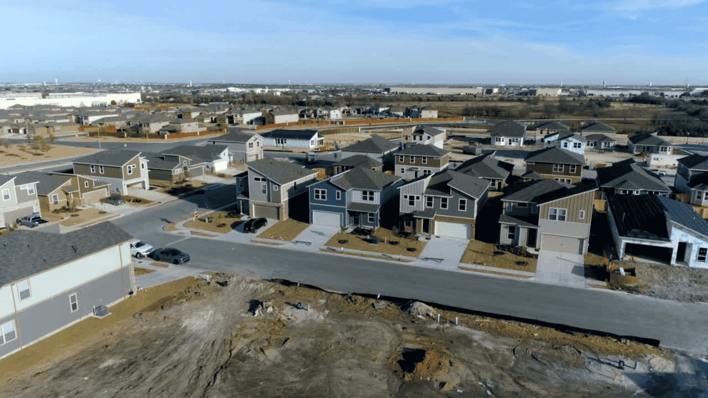Should You Buy a New Construction Home? A Deep Dive for Texas Buyers
 Author: Michael Bernstein
Author: Michael BernsteinPublished:
From the outside, buying a brand-new home seems like a no-brainer: no outdated plumbing, no 1980s wallpaper, and no seller to haggle with over repairs. For many homebuyers in Texas—especially in booming suburbs like Leander, Round Rock, and the growing outskirts of Houston—new construction homes are increasingly appealing. These homes offer modern design, custom finishes, and amenity-rich communities. But the process isn’t always as polished as the granite countertops.
Behind the glossy model homes and builder incentives lie real risks: questionable construction quality, tricky financing packages, and trade-offs many buyers don’t anticipate until it’s too late. In this article, we’ll walk through what it really means to buy new construction in Texas—the pros, cons, common traps, and how to protect yourself.

Why So Many Texans Are Choosing New Construction
Location, affordability, and lifestyle. That’s the equation driving buyers to places like Leander and Round Rock just outside Austin, and sprawling new neighborhoods north and west of Houston. The land is cheaper than in city centers, which means developers can build big homes with shiny finishes and still hit a price point that appeals to first-time buyers and growing families.
Plus, many of these homes are part of master-planned communities, which come loaded with features: community pools, fitness centers, pickleball courts, walking trails, dog parks, and even on-site schools. It’s not just about the house—it’s about the lifestyle.
Buyers also like the idea of moving into something brand new. There’s no need to worry about roof replacements, foundation issues, or outdated electrical work. Most builders offer warranties that cover major systems for the first 1–2 years, and structural issues for up to 10.
Master-Planned Communities: Perks and Pitfalls
These aren’t just homes—they’re neighborhoods with built-in appeal. Developers like DR Horton, Lennar, and Perry Homes aren’t just selling you a property; they’re selling you an environment.
But there’s a trade-off: HOAs. Homeowner associations come with monthly or annual fees (often $500–$1,200/year, and sometimes more depending on the amenities) and a set of rules that govern everything from your landscaping to whether you can park your RV in the driveway.
HOA pros:
- Keeps the community clean and uniform: By enforcing rules around lawn care, exterior paint colors, and home maintenance, HOAs can prevent a single property from dragging down neighborhood curb appeal. This consistency can help preserve the value of all homes in the community.
- Manages and maintains shared amenities: Your HOA dues go toward the upkeep of parks, pools, trails, and community centers—keeping them in good condition without relying on volunteer efforts. Without an HOA, those amenities might fall into disrepair or be funded by sporadic special assessments.
- Helps protect long-term home values: When a neighborhood looks cared for and consistent, homes tend to appraise higher and attract more buyers, even years after you’ve moved in. In many cases, appraisers and buyers will view HOA-governed communities more favorably.
HOA cons:
- Restricts personalization: You may not be able to install solar panels, paint your home a unique color, or add exterior features without approval. Want to keep a boat in the driveway or build a shed? You might need explicit written permission—or be denied altogether.
- Adds to your annual costs: HOA fees are a recurring, required cost on top of your mortgage, property taxes, homeowners insurance, and utility bills. A $100/month HOA fee means an extra $1,200 per year out of your pocket—money that doesn’t reduce your mortgage balance or build equity. And fees can increase over time, especially if the HOA board votes to add services or cover new maintenance projects.
- Can become contentious: If the HOA board enforces rules unevenly, adds new restrictions, or fails to manage the community transparently, you might find yourself locked in disputes. Some boards are professionally managed and responsive; others are underfunded or mismanaged, making communication difficult and conflict more likely.
Before signing, ask to read the HOA documents. Know what you’re agreeing to—including financial obligations, architectural restrictions, enforcement procedures, and your rights as a homeowner within the community.
The Hidden Risks of "Brand New"
New construction homes may look perfect on the surface, but many come with hidden defects—and sometimes, hidden health risks. One of the biggest misconceptions buyers have is that a brand-new home is flawless because everything is unused. In reality, construction shortcuts, material issues, and rushed timelines can result in homes that need major fixes soon after move-in.
During the pandemic building boom, many builders operated under extreme labor shortages and strained supply chains. This led to a rise in homes with foundational cracks, warped flooring, incomplete insulation, and improperly installed HVAC systems. In some cases, corners were cut just to meet deadlines, leaving critical systems like plumbing and electrical work prone to failure.
But the risks don’t stop at comfort or resale value—they can also affect your health. Recent reports have shown that
some new homes contain excessive construction dust, improperly vented gas appliances, or fresh materials that off-gas harmful volatile organic compounds (VOCs). Without proper ventilation, those pollutants can lead to chronic respiratory irritation, headaches, and other symptoms—especially in airtight, energy-efficient homes.
You might also encounter:
- Mold growth from rushed or poorly sealed construction
- Radon exposure in homes without proper mitigation systems
- Poor indoor air quality due to low-grade materials or oversights during build-out
That’s why getting a home inspection is critical. Even if the home is brand new, hiring a licensed third-party inspector ensures someone is checking behind the builder’s crew—not just for structural or cosmetic issues, but also for safety and livability.
We strongly recommend every buyer read our full guide: Why Every Buyer in Austin Should Get a Home Inspection.
Inspection Tips:
- Do a pre-drywall inspection (before walls go up)
- Schedule a full inspection before your final walkthrough
- Review any signs of moisture, HVAC inconsistencies, or ventilation issues
- Flag any concerns about materials or odors that might point to health hazards
Your builder may resist or downplay the need for outside inspections—but this step can save you thousands in repairs and offer peace of mind about your long-term health and comfort.
Be Wary of The Builder’s Lender
Here’s something most buyers don’t realize: Builders often have a preferred or affiliated lender, and they’ll offer big incentives (like $10,000 in closing cost credits) if you use them.
Sounds great, right? Not always.
Those builder credits often come at the cost of a much higher mortgage rate. That’s because the builder and their lender are making back those credits—and then some—over the life of the loan.
While using a builder’s lender can simplify paperwork and timelines, it often limits your choices and may lead to higher borrowing costs. According to The Mortgage Reports, some preferred lenders may lock you into less competitive terms, padded rates, or fees that offset the value of the upfront incentives.
Real Example: LendFriend worked with a borrower named Jawon, who was quoted a 7.25% rate by the builder’s lender—with $6,000 in closing credits.
We helped him secure a 6.625% rate with no points, saving him over $150/month and more than $10,000 in total interest over 5 years.
“This is my first time working with LendFriend, and I am completely satisfied with their service. They ended up being a back-up option when my builder's preferred lender was unable to fulfill the terms for my mortgage. LendFriend immediately stepped in and came in nearly $15k less than what the preferred lender quoted me. The team is extremely professional, and I would definitely work with them again in the future.” —Jawon A.
Always shop your mortgage. Credits are nice, but the rate matters too. At the end of the day, it’s all a math equation and you always need to shop your mortgage, whether you’re buying a new construction or an existing home.
The Pros and Cons of New Construction
Pros:
- Brand-new everything: From roofing and HVAC to appliances and flooring, everything is untouched and under warranty—giving you peace of mind and fewer upfront repair expenses.
- Modern layouts with energy-efficient systems: Today’s new homes often feature open floor plans, smart-home wiring, tankless water heaters, and energy-efficient HVAC systems that lower utility bills.
- Potential for customization: Depending on the builder and the stage of construction, you can often choose finishes, flooring, countertops, and even structural upgrades to match your lifestyle and tastes.
- Community amenities: Master-planned communities commonly include pools, parks, gyms, trails, and dog-friendly spaces—all included in your HOA dues, offering a resort-like lifestyle.
- Lower maintenance in the first 5 years: With everything new and under warranty, you’re far less likely to face surprise repair bills or renovations during your early years of ownership.
Cons:
- Construction quality varies widely: Not all builders are created equal. Some cut corners or rely on subcontractors with inconsistent craftsmanship, especially during labor shortages.
- Often far from city centers: Many new communities are located on the outskirts of metro areas. In places like Leander, Round Rock, or the Houston suburbs, that can mean long commutes and limited access to walkable amenities.
- Delays and change orders are common: Construction timelines can shift due to weather, material shortages, permitting delays, or labor availability. Some buyers face delays of several months.
- HOA fees and restrictions: As discussed earlier, HOA dues add to your annual expenses and come with rules that may limit how you personalize your home or use your property.
- Builder lenders may offer higher rates: While their incentives can be tempting, their mortgage rates aren’t always the best deal—especially when compared to what you could get from an independent mortgage broker like LendFriend.
If you're buying in Leander or Round Rock, expect to be about 30-40 minutes from downtown Austin in traffic. In Houston, new construction is booming in places like Cypress, Katy, and Manvel—all great suburbs, but a long haul for inner-loop commuters.
What to Know Before You Buy
- Use a Real Estate Agent Many buyers think they can go it alone with the builder's sales rep. But that rep works for the builder—not you. A good agent can:
- Negotiate upgrades or credits: Builders are often more flexible on extras than they are on price. An experienced agent can negotiate things like upgraded countertops, better appliances, smart home systems, or even lot premiums—things you might not realize are negotiable.
- Review your contract: New construction contracts are lengthy and heavily favor the builder. A real estate agent can help you understand what you're signing, flag concerning terms, and refer you to a real estate attorney if needed.
- Help coordinate inspections: Most builders won’t stop you from bringing in your own inspector—but they won’t remind you to, either. A buyer’s agent will make sure you know when and how to schedule pre-drywall and final inspections, and will help communicate with the builder on repair requests.
And best of all? The builder pays their commission, not you.
- Ask About the Timeline New builds can be delayed by weather, permits, supply shortages, or labor gaps. Always ask for a realistic estimate and build in flexibility with your move-out/move-in plans.
- Don’t Skip the Inspection We’ll say it again: Get. An. Inspection. Even if it’s new.
- Get Multiple Mortgage Quotes Yes, the builder’s lender may offer incentives. But always compare.
Pro tip: Some outside lenders (like LendFriend) are capable of matching the builder’s credit and offering a better rate—you just have to get a quote.
Final Thoughts: New Construction Done Right
A new construction home in Texas can be a dream come true—especially if you want modern features, planned communities, and a low-maintenance start. But that dream can quickly sour if you don’t go in with a plan.
So here’s what to remember:
- Inspect everything, even when it’s brand new
- Read the fine print on HOAs and builder contracts
- Compare mortgages, and don’t blindly accept the builder’s lender
- Use a real estate agent to protect your interests
LendFriend is here to help you run the numbers, compare rates, and figure out the smartest way to finance your new home—without getting stuck with a high rate just to score some builder credits.
If you want to discuss how we view the housing market and rates in light of the AI craze, give us a call at 512.881.5099 or get in touch with me by completing this quick form, and I'll be in touch as soon as possible.

About the Author:
Michael Bernstein